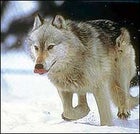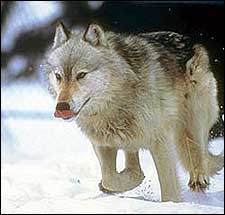���ϳԹ���‘s October 2003 Dispatch, “Back in the Crosshairs,” explores the raging controversy between environmentalists and ranchers over the proposed removal of the gray wolf from the federal endangered species list. Here, we discuss the delisting issue with wolf expert and former Yellowstone naturalist .
Gray Wolf Forum
to share your opinion about the gray wolf delisting controversy. Wolf Number Ten, released in Montana during the 1995 reintroduction project
Wolf Number Ten, released in Montana during the 1995 reintroduction project
���ϳԹ��� Online: In your 1996 book, The Yellowstone Wolves, you chronicled the 1995 reintroduction of wolves into Yellowstone National Park. At that time, did you foresee that the recovery of wolf populations would be as widespread as it is today?
Ferguson: No, I did not, and certainly the biologists did not foresee such a remarkable recovery either. Their target population in order to consider delisting across all three recovery zones—Yellowstone, northwest Montana, and central Idaho—was 300 wolves. And now there are 600-plus wolves, so I think everybody was taken aback by how well they did.
How did the recovery of the wolf come about and why was it so important to so many people?
Well, the Endangered Species Act of 1973 allowed the wolves to be identified as an important species—a target species, and one of the reasons it’s so important is that a major predator like the wolf has a profound impact on the entire ecosystem. In fact, Doug Smith, who is the wolf recovery project leader in Yellowstone, is fond of saying that in 25 years wolves will be to Yellowstone what water is to the Everglades. Basically, everything in the ecosystem will be impacted by their presence. I think people are excited about the wolf coming back not just because it’s a sexy predator but because it also has a remarkably important role in a healthy ecosystem.
In your book, you also said that wolves will be seen as either devils or gods. How has that become true in the time since their reintroduction?
Well, there have now been roughly 120,000 wolf sightings in Yellowstone, mostly from the roads, most of them from packs of visitors who have come from all over the world. Economists now estimate there’s about $25 million a year being left just by wolf watchers in communities surrounding the greater Yellowstone ecosystem. That enthusiasm sometimes borders on worship. For some reason, the wolf captures the imagination in a way that other animals just don’t do. On the other side of the fence, the devil aspect: that’s what’s concerning me more because, while in some areas ranchers have accepted the fact that the world is not necessarily coming to an end, there is a firm entrenchment in the anti-wolf forces right now. I’ve heard over and over again that within ten years all the ungulates—all the elk, all the deer, all the moose—will be completely wiped out. And wolves have even become the symbol of choice to point to all that’s wrong with America, which is usually manifested for these guys through the actions of the federal government. So this argument over wolves is not as much about the wolf as a creature as it is about the wolf as a symbol?
I think so, at least that’s been my experience. If you ask somebody who’s predicting these doom-filled scenarios, how it’s possible that the ungulates survived in the presence of wolves for thousands of year without us being here, well, the most common response is that these are not the wolves that were here—that we brought down some bizarre subspecies from Canada that likes to kill for fun. I can’t tell you how many times I’ve heard that wolves are down in the range just killing elk to chew their lips off. It’s really fascinating if you know the history of wolves and how often they have been used as a symbol—for example in the Middle Ages, by the Catholic church as a symbol of Satan—to see them employed now as a symbol by both sides. It really speaks to the level of enchantment this animal has.
In ���ϳԹ���‘s October 2003 Dispatch, Bruce Barcott quotes wildlife biologist Renée Askins, who is concerned that there may be a wolf-killing free-for-all after the species is delisted. Some environmentalists are worried that the decline in wolves would be too drastic to do anything about it before it’s too late. What’s your take on these fears?
I think Renée does make a good point, and the other environmentalists do too, especially if you have a situation as they proposed in Wyoming, where everywhere but in the national parks and adjacent wilderness areas the wolf is a predator. Then I do agree that that group of people who absolutely hate wolves with a passion will not hesitate to go out of their way to gun them down. And so those wolves that stray out of protected areas would suffer. Whether that compromises the viability of wolves in greater Yellowstone is another question, but it does bring up some concerns that I think are worth chewing on, there’s no doubt about it.
A lot of environmental advocacy organizations are lobbying against the delisting of the wolf already. Why exactly is this?
Well, this is an interesting thing and I think it’s going to be quite controversial because in truth, compared to, say, the grizzly bear, I think the wolf is a remarkably resilient animal. There’s no question that it is able to adapt to unfortunate circumstances in a way that other animals can’t. I think my concern about delisting the wolf right now is focused on Wyoming. The state legislature, just as Idaho’s state legislature and Montana’s legislature, has to come up with a management plan that seems reasonable and of course ensures the sustainability of the wolf population in perpetuity. Wyoming has drug its feet for a long time coming up with anything that comes close to being usable. What they just voted on in August actually divides wolves into two classes: trophy animals and predators. If a wolf reaches an area where it is defined as a predator, it can be basically shot by anyone, anytime, for any reason. It’s not a very well though out plan, and until the state of Wyoming comes up with something that is going to assure the long-term survival of these wolf packs, I think they’re not going to be delisted.
If the gray wolf were delisted, would we see a drastic increase in livestock fatalities?
I think with a good, sound, management plan in place in each of the states, we would see a manageable level of predation. Really there are a lot of reasons why a sheep or a cow dies, especially on public grazing allotments in wild country, with a full range of predators and a full range of other risks that any animal in that wilderness would face. The livestock depredation that we see, while it is increasing as the numbers increase, is just a tiny portion of how livestock die by other means.
Do you think there is some sort of compromise in our future, between the environmentalists and the ranchers?
I think if the reasonable elements of both groups would get together—and they do make up a majority—I think there’s absolutely a possiblity of that happening. Unfortunately, what seems to happen sometimes is that extremists on both sides end up controlling the debate. And that leads them to basically stand on opposite sides of the fence and throw rocks at each other. Until the heart of the ranching and hunting communities and the heart of the conservation and environmental movement get together and take control of the stage, and therefore take control of policy development, we’re going to continue to swing back and forth between these extreme positions. That’s unfortunate because then both wildlife and livelihoods like ranching suffer.
Do you think it’s reasonable to take the gray wolf off the endangered species list now?
I would say that when Idaho, Wyoming, and Montana have wolf management plans in place that clearly do consider the biological and ecological necessities of this animal, I think it’s then okay to delist them. And I do have faith that if the U.S. Fish and Wildlife Service applies themselves as they often have in the past, and if science prevails rather than politics, I have no problem delisting them. I think the actual act of delisting sends a powerful, positive message to the American public that says, “Look, we can apply this much beleaguered act, the Endangered Species Act, and restore an important part of an ecosystem.” And if we continue to use the endangered species list forever, simply because of the somewhat greater protection it offers—with no animal ever coming off of that list—then I think the Endangered Species Act will lose public support in the decades to come.
So it’s possible to take the wolf off the list and manage it sustainably?
I think so. And of all the animals, I think when acceptable management plans are in place, few would be more qualified to be taken off than wolves, simply because of their very complex, very advanced ability to react to changing environmental conditions. Not every animal has that ability to react in the myriad ways the wolf does.
When could we expect the wolf to be delisted?
Well, I would imagine that Wyoming will come up with something that meets the approval of the U.S. Fish and Wildlife Service within the next 18 months. I think there will be an onslaught of lawsuits against delisting by a variety of environmental groups, some with good concerns, some with perhaps not such good concerns. By the time those lawsuits are worked through, I think it could be five or six years down the road before de-listing actually happens. I would encourage environmental groups to be very careful in how they apply their energies, to make sure that they’re fighting the battles that need to be fought, and not taking on the delisting of wolves past the time when it makes sense to do so and when there are so many other issues that truly need their attention. The environmental movement really has a responsibility to build some credibility and good will and a sense of working with communities as well as with wild ecosystems in these great battles, and I hope they will do so. I have seen a lot of movement in that direction.
What can we expect the lawsuits will do? Will they actually reverse decisions or just buy more time?
I think if the U.S. Fish and Wildlife Service listens to their scientists, lets them determine whether these state management plans are sound or not, and gives them their stamp of approval, then it will simply be a matter of buying more time for the wolf to remain on the endangered species list. I think ultimately they will be removed. It’s just a matter of how quickly the lawsuits are considered by the courts.
How do you see gray wolves faring over the course of the next century?
With a reasonable management plan in place and with some kind of a comprehensive effort to protect the habitat that supports the prey base that wolves need, I think wolves will do extremely well in the next hundred years. They have shown themselves to be as adaptable and clever and intelligent as any animal the world has. I would say that with a good management plan and habitat protection for the prey base, wolves will thrive in the next century.
Click here to read more about and the from our online partner, .


